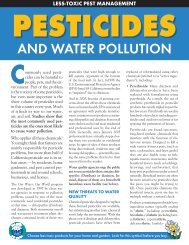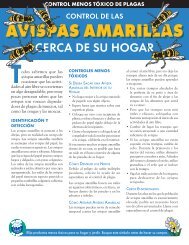Use and Disposal of Pesticides - Our Water Our World
Use and Disposal of Pesticides - Our Water Our World
Use and Disposal of Pesticides - Our Water Our World
Create successful ePaper yourself
Turn your PDF publications into a flip-book with our unique Google optimized e-Paper software.
LESS-TOXIC PEST MANAGEMENTUSE AND DISPOSAL OFPESTICIDESPESTICIDESEven when applied accordingto label directions,pesticides make theirway into our waterways, air, rain<strong>and</strong> fog. Even small amounts <strong>of</strong>pesticides can be lethal to marinelife, birds, <strong>and</strong> other lifeforms. Just one granule or seedtreated with diazinon, a commonhousehold pesticide, isenough to kill a small bird. Sowhat can we do? Instead <strong>of</strong> relyingon conventional pesticidesas our first line <strong>of</strong> defenseagainst a pest, consider them asa last resort. Check out theother fact sheets in this seriesfor tips on safer <strong>and</strong> effectivealternatives for preventing <strong>and</strong>managing pest problems in yourhome <strong>and</strong> garden. For more information,contact the sourceslisted on the reverse side <strong>of</strong> thisfact sheet.IF YOU MUST USEPESTICIDES:• Identify the pest <strong>and</strong> the afflictedplant, <strong>and</strong> then choose a productlabeled for use on that pest <strong>and</strong>plant. Not all pesticides are effectiveagainst all pests.• Aerosols may be the worst optionyou can choose for pest problems.They disperse chemicals in a waythat significantly increases the risk<strong>of</strong> exposure to unintentional targets,including beneficial insects, birds,pets, you <strong>and</strong> your family.• Choose the least-toxic productavailable. Baits <strong>and</strong> traps are saferoptions.• Spot treat whenever possible.• Buy ready-to-use products instead <strong>of</strong>concentrates. An undiluted pesticidethat requires mixing is more hazardousthan one that is already diluted.And, ready-to-use products avoidthe use <strong>of</strong> measuring <strong>and</strong> mixing thatcould result in spills. When rinsinga pesticide from measuring cups, applicatorsor containers, use the rinseas you would the pesticide — for thetarget pest. Don’t wash it down adrain. (See Proper <strong>Disposal</strong> section.)• Read the label <strong>and</strong> use only theamount recommended to do thejob. More is not better.• If the label instructs you to use protectivegear, heed the advice — yourhealth could depend on it. The use<strong>of</strong> gloves, for example, is not intendedto avoid staining your h<strong>and</strong>s;rather, it <strong>of</strong>fers protection againsthaving the chemicals enter yourblood stream through your skin.• Homeowners who apply pesticidesoutdoors (including applications onlawns) can unknowingly carry residuesinto their home on clothing <strong>and</strong> shoes.Pets can also be carriers. Be mindfulthat residues, whether tracked in fromoutdoors or as a result <strong>of</strong> indoor use,can contaminate carpets <strong>and</strong> floorswhere children play.KNOW WHAT YOU’REBUYING• Just because a product is purchasedover-the-counter, doesn’t mean that ithas been tested for its ability to causelong-term health or environmentalSIGNAL WORDSCaution, Warning, <strong>and</strong> Dangerare signal words placed on productlabels to alert consumers tothe relative toxicity <strong>of</strong> the products— Caution being the leasttoxic <strong>and</strong> Danger being the mosttoxic. These signal words, however,pertain only to the acute orimmediate hazard <strong>of</strong> the product.Labels do not provide informationabout the chronic or long-termhazards to humans, animals or theenvironment. For example, nothingon the product label tells youwhether a product contains achemical suspected <strong>of</strong> causingbirth defects, kidney or liver damage,cancer, lung disease, etc.Choose less toxic products for your home <strong>and</strong> garden. Look for this symbol before you buy.
INERT INGREDIENTSInert ingredients (called “inerts” or“other ingredients” on product labels)can comprise up to 99.9% <strong>of</strong>a pesticide product. Contrary towhat the name implies, inerts arenot necessarily safe chemicals —nor have they necessarily beentested for any long-term health implicationslike cancer, nervous systemdamage, reproductive harm,or gene mutations. If you want totry to avoid exposure to chemicalssuspected <strong>of</strong> causing long-termhealth impacts, select pest controlproducts that are non-toxic (e.g.,traps), those that <strong>of</strong>fer the leastamount <strong>of</strong> pesticide exposure (e.g.,baits), or those that <strong>of</strong>fer the leasttoxic chemical (e.g., horticulturaloil). For more information onchoosing the least-toxic pest controlproduct available, refer to theother fact sheets in this series orcontact the organizations listed inthis fact sheet. For more informationon inert ingredients, go to:www.pesticide.org.damage. In 2001, the U.S. EnvironmentalProtection Agency worked withproduct manufacturers to remove thepesticide Dursban (or chlorpyrifos)from being sold because <strong>of</strong> its toxicityto children. Chlorpyrifos was first registeredfor sale in 1965. Diazinon, aclose relative, will be removed fromstores shelves by 2005 — also because<strong>of</strong> its toxicity to children. It has beenregistered for sale since 1956.• Research has shown that pesticideresidues are detected on many foodspurchased from grocery stores. Formore information about pesticides infood, go to: www.foodnews.org (EnvironmentalWorking Group); orcall the Natural Resources DefenseCouncil at (415) 777-0220.• If you have any questions about thesafety, environmental impact, orproper use <strong>of</strong> a pesticide, call the NationalPesticide Information Center24-hour hotline at (800) 858-PEST,www.npic.orst.edu.STORING PESTICIDESAND APPLICATIONEQUIPMENT• Store pesticides in their original containers,in a place that cannot beaccessed by children or pets.• Never remove the labels.• Clearly mark containers, applicators<strong>and</strong> utensils used for mixing or applyingpesticides <strong>and</strong> store them withthe pesticides. Never use them forany other purpose.DISPOSE OF PESTICIDESSAFELY AND LEGALLY• Unwanted pesticides should bebrought to your local household hazardouswaste collection program. InCalifornia, it’s illegal to dispose <strong>of</strong> partiallyused containers <strong>of</strong> pesticides (orany hazardous waste) in the trash, inspite <strong>of</strong> what the label says. It is legalto dispose <strong>of</strong> empty (no free-flowingliquid) pesticide containers in the trashif they are 5 gallons or less in capacity.• Never dispose <strong>of</strong> pesticide-taintedwater in any indoor or outdoordrain. Though indoor drains flow totreatment plants, pesticides can passright through the plants <strong>and</strong> enterlocal waterways. <strong>Water</strong> used to rinseout a sprayer or applicator should beapplied like the pesticide. In mostcommunities, outdoor drains flowdirectly to local waterways.• Never use or give away any pesticidethat is no longer available in themarketplace such as chlordane,DDT, <strong>and</strong> chlorpyrifos (Dursban).• For more information on pesticidedisposal, call 1-800-CLEANUP orvisit: www.1800CLEANUP.org.PESTICIDES ANDWATER POLLUTIONCommon household pesticides show up intreated wastewater <strong>and</strong> in local waterways,sometimes at levels that can harm sensitiveaquatic life. So, water pollution preventionagencies have teamed up with participatingretail stores, pesticide distributors, <strong>and</strong> manufacturersto reduce the risks associated withpesticide use. This fact sheet is part <strong>of</strong> a series<strong>of</strong> fact sheets <strong>and</strong> store displays aimed ateducating residents about less-toxic pestmanagement. For the rest <strong>of</strong> the series <strong>of</strong> factsheets, visit www.ourwaterourworld.org.Also, look for the “<strong>Our</strong> <strong>Water</strong> <strong>Our</strong> <strong>World</strong>”logo next to products in participating stores<strong>and</strong> nurseries. See the <strong>Pesticides</strong> <strong>and</strong> <strong>Water</strong>Pollution fact sheet for information on activeingredients in common pesticides thatmay cause water quality problems.Pest control strategies <strong>and</strong> methods describedin this publication are consistent with integratedpest management (IPM) concepts, <strong>and</strong>are based on scientific studies <strong>and</strong> tests in actualhome <strong>and</strong> garden settings. <strong>Use</strong> suggestedproducts according to label directions <strong>and</strong>dispose <strong>of</strong> unwanted or leftover pesticidesat a household hazardous waste collectionfacility or event. For more information onpesticide disposal, call 1-800-CLEANUP orvisit: www.1800CLEANUP.org. No endorsement<strong>of</strong> specific br<strong>and</strong> name products is intended,nor is criticism implied <strong>of</strong> similar productsthat are not mentioned.ACKNOWLEDGMENTThe Central Contra Costa Sanitary Districtoriginally developed this IPM outreachprogram.FOR MORE INFORMATIONFor more information, contact:Bio-Integral Resource Center (BIRC)(510) 524-2567; www.birc.orgUniversity <strong>of</strong> California CooperativeExtension Master Gardeners in your area(in the phone book )University <strong>of</strong> California IPM website:www.ipm.ucdavis.eduwww.ourwaterourworld.orgJanuary 2007Paper content: 15% Post-consumer waste,50% Recycled, <strong>and</strong> Processed chlorine free





